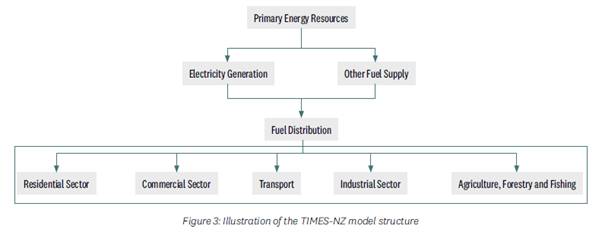Tool
About the Tool
We have developed an interactive tool to explore the results of the model and provide some insight into our future energy system. We hope you find the tool useful.
TIMES-NZ 2.0 is a technology-based optimisation model that represents the entire New Zealand energy system, encompassing energy carriers and processes from primary resources to final energy consumption. The model is based on the International Energy Agency Energy Technology Systems Analysis Program TIMES model, an energy system model that has been used by over 60 countries worldwide.
TIMES-NZ 2.0 has been adapted for the New Zealand energy system, incorporating both technical engineering and economic considerations. The bottom-up model selects from available technologies to produce a least-cost energy system, optimised according to input constraints over the medium to long-term.
Scenarios
TIMES-NZ 2.0 provides you with two plausible and coherent stories about New Zealand’s energy future:
Kea
Kea (Cohesive) represents a scenario where climate change is prioritised as the most pressing issue and New Zealand deliberately pursue cohesive ways to achieve a low-emissions economy.
Tūī
Tūī (Individualistic) represents a scenario where climate change is an important issue to be addressed as one of many priorities, with most decisions being left up to individuals and market mechanisms.
Model Assumptions
From a modelling perspective, the two scenarios differ in terms of the assumptions and data inputs to the model. The key model input differences between Kea and Tui are:
- GDP assumptions
- Carbon price input assumptions
- Technology cost curves
- Discount rates
Model Structure
TIMES-NZ 2.0 has a modular structure that encompasses resource supply, electricity generation, other fuel supply, fuel distribution, and demand sectors as illustrated below. The five demand sectors are Residential, Commercial, Industrial, Agriculture Fishing and Forestry, and Transport, which are disaggregated further into subsectors.

Fuels have been grouped as “Fossil Fuels”, “Renewables (direct use)”, and “Electricity”. Green Hydrogen, which is produced from electrolysis, is included in the Electricity group. Blue Hydrogen, produced from Steam Methane Reforming (SMR) with Carbon Capture and Storage (CCS), is included in the Fossil Fuels group.
For more details about the model structure and input assumptions refer to
New Zealand Energy Scenarios TIMES-NZ 2.0 – A guide to understanding the TIMES-NZ 2.0 model.
